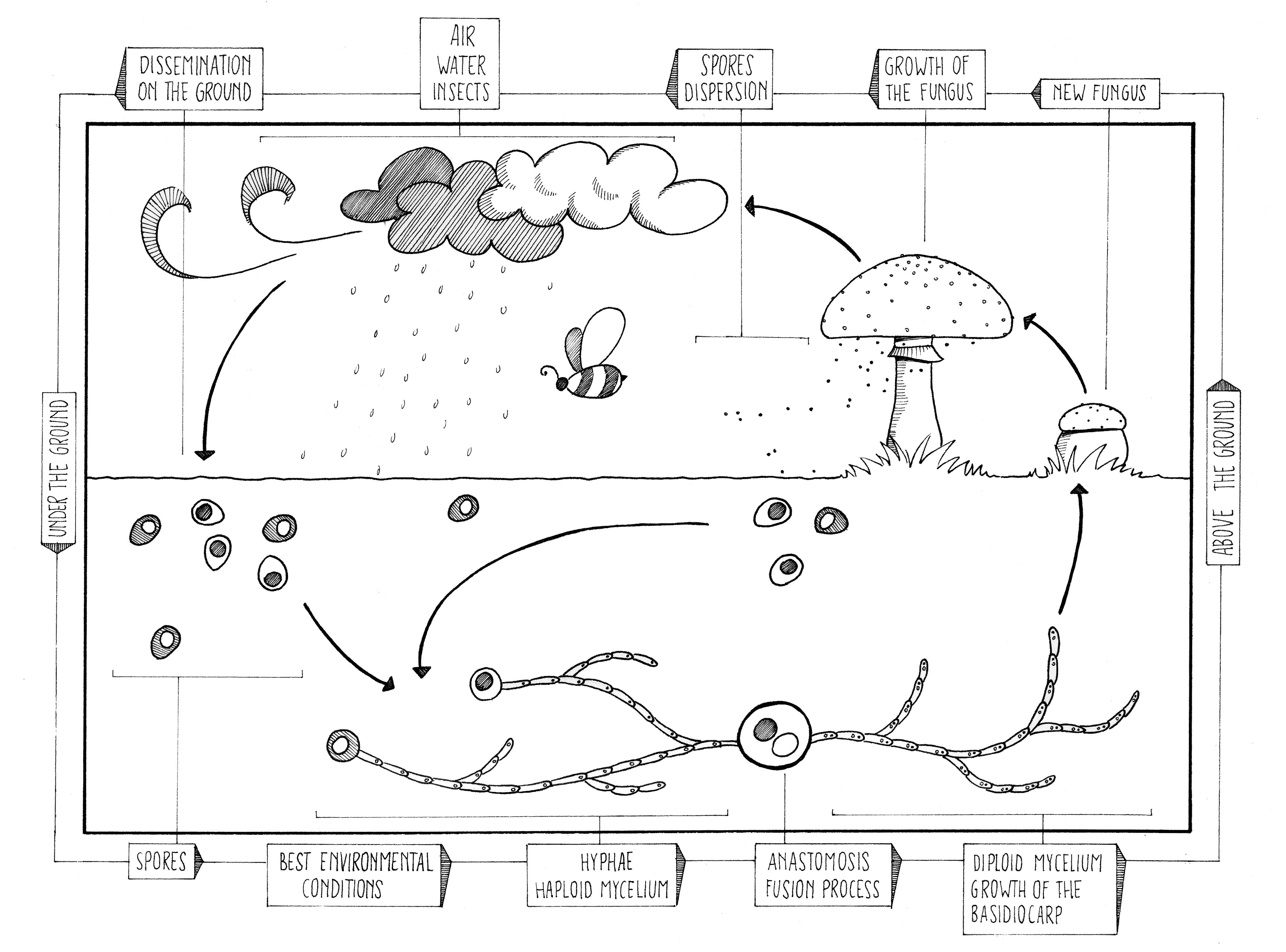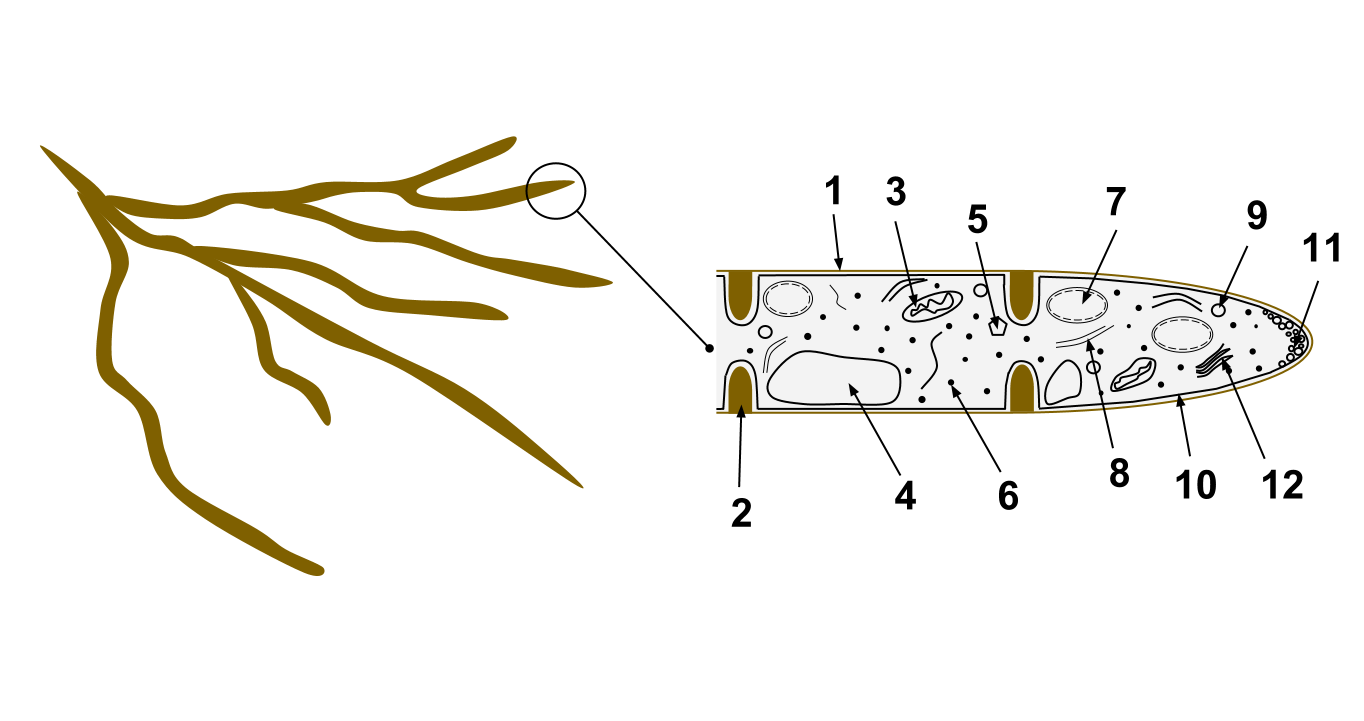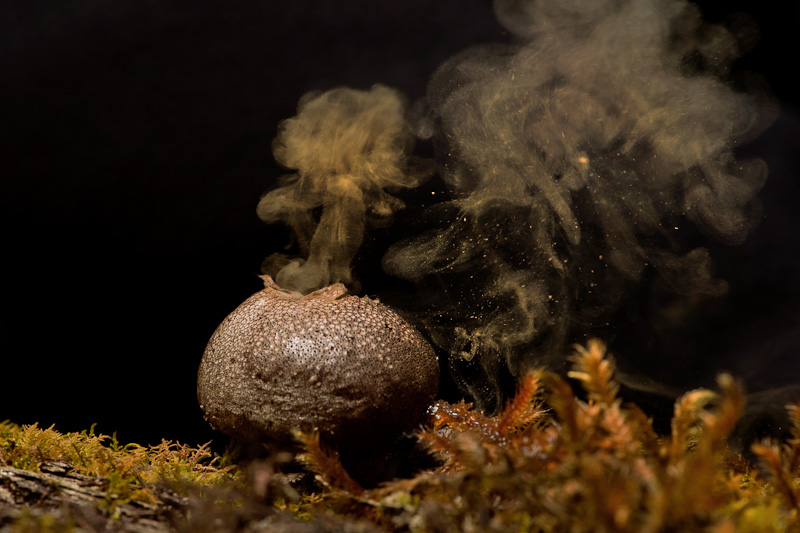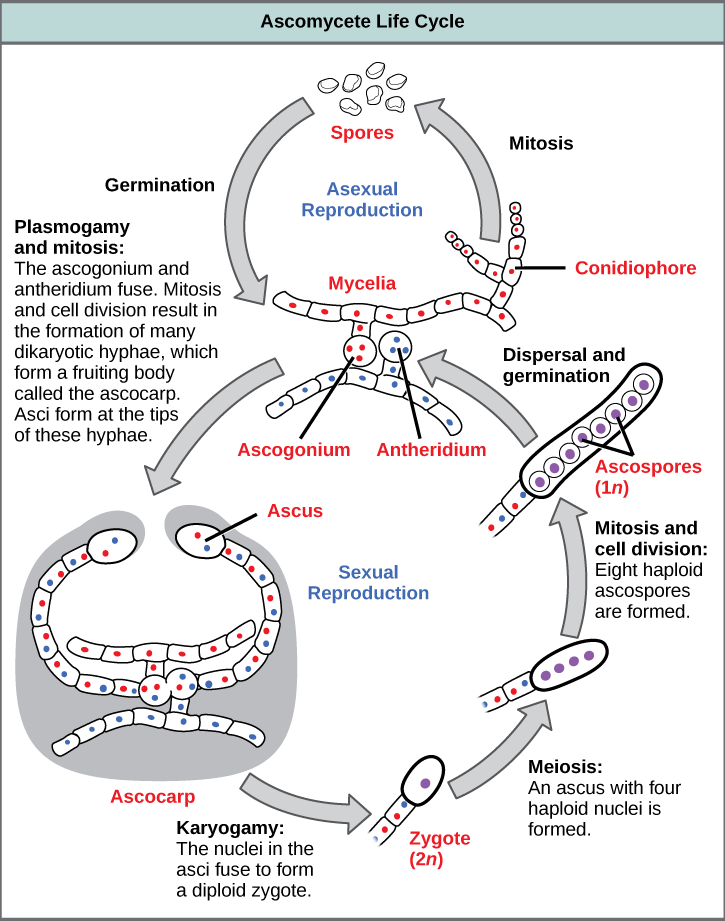|
Basidiomycetes
Basidiomycota () is one of two large divisions that, together with the Ascomycota, constitute the subkingdom Dikarya (often referred to as the "higher fungi") within the kingdom Fungi. Members are known as basidiomycetes. More specifically, Basidiomycota includes these groups: mushrooms, puffballs, stinkhorns, bracket fungi, other polypores, jelly fungi, boletes, chanterelles, earth stars, smuts, bunts, rusts, mirror yeasts, and '' Cryptococcus'', the human pathogenic yeast. Basidiomycota are filamentous fungi composed of hyphae (except for basidiomycota-yeast) and reproduce sexually via the formation of specialized club-shaped end cells called basidia that normally bear external meiospores (usually four). These specialized spores are called basidiospores. However, some Basidiomycota are obligate asexual reproducers. Basidiomycota that reproduce asexually (discussed below) can typically be recognized as members of this division by gross similarity to others, by the forma ... [...More Info...] [...Related Items...] OR: [Wikipedia] [Google] [Baidu] |
Fungi
A fungus (plural, : fungi or funguses) is any member of the group of Eukaryote, eukaryotic organisms that includes microorganisms such as yeasts and Mold (fungus), molds, as well as the more familiar mushrooms. These organisms are classified as a Kingdom (biology), kingdom, separately from the other eukaryotic kingdoms, which by one traditional classification include Plantae, Animalia, Protozoa, and Chromista. A characteristic that places fungi in a different kingdom from plants, bacteria, and some protists is chitin in their cell walls. Fungi, like animals, are heterotrophs; they acquire their food by absorbing dissolved molecules, typically by secreting digestive enzymes into their environment. Fungi do not photosynthesize. Growth is their means of motility, mobility, except for spores (a few of which are flagellated), which may travel through the air or water. Fungi are the principal decomposers in ecological systems. These and other differences place fungi in a single gro ... [...More Info...] [...Related Items...] OR: [Wikipedia] [Google] [Baidu] |
Ustilaginomycotina
The Ustilaginomycotina is a subdivision within the division Basidiomycota of the kingdom Fungi. It consists of the classes Ustilaginomycetes and Exobasidiomycetes, and in 2014 the subdivision was reclassified and the two additional classes Malasseziomycetes and Moniliellomycetes added. The name was first published by Doweld in 2001; Bauer and colleagues later published it in 2006 as an isonym. Ustilagomycotina and Agaricomycotina are considered to be sister groups, and they are in turn sister groups to the subdivision Pucciniomycotina. Ustilaginomycotina comprises 115 genera with more than 1700 species. The subdivision is mostly plant parasites on vascular plants, and the distribution of the subdivision is therefore restricted to the distribution of the host. The group is also called the true smut fungi because of the production of teliospores. The name smut is still used as a term since it circumscribes the organization and life cycle of Ustilaginomycotina, but it is not a ... [...More Info...] [...Related Items...] OR: [Wikipedia] [Google] [Baidu] |
Polypore
Polypores are a group of fungi that form large fruiting bodies with pores or tubes on the underside (see Delimitation for exceptions). They are a morphological group of basidiomycetes-like gilled mushrooms and hydnoid fungi, and not all polypores are closely related to each other. Polypores are also called bracket fungi or shelf fungi, and they characteristically produce woody, shelf- or bracket-shaped or occasionally circular fruiting bodies that are called conks. Most polypores inhabit tree trunks or branches consuming the wood, but some soil-inhabiting species form mycorrhiza with trees. Polypores and the related corticioid fungi are the most important agents of wood decay, playing a very significant role in nutrient cycling and aiding carbon dioxide absorption by forest ecosystems. Over one thousand polypore species have been described to science, but a large part of the diversity is still unknown even in relatively well-studied temperate areas. Polypores are much more ... [...More Info...] [...Related Items...] OR: [Wikipedia] [Google] [Baidu] |
Basidium
A basidium () is a microscopic sporangium (a spore-producing structure) found on the hymenophore of fruiting bodies of basidiomycete fungi which are also called tertiary mycelium, developed from secondary mycelium. Tertiary mycelium is highly-coiled secondary myceliuma dikaryon. The presence of basidia is one of the main characteristic features of the Basidiomycota. A basidium usually bears four sexual spores called basidiospores; occasionally the number may be two or even eight. In a typical basidium, each basidiospore is borne at the tip of a narrow prong or horn called a sterigma (), and is forcibly discharged upon maturity. The word ''basidium'' literally means "little pedestal", from the way in which the basidium supports the spores. However, some biologists suggest that the structure more closely resembles a club. An immature basidium is known as a basidiole. Structure Most basidiomycota have single celled basidia (holobasidia), but in some groups basidia can be ... [...More Info...] [...Related Items...] OR: [Wikipedia] [Google] [Baidu] |
Pucciniomycotina
Pucciniomycotina is a subdivision of fungus within the division Basidiomycota. The subdivision contains 9 classes, 20 orders, and 37 families. Over 8400 species of Pucciniomycotina have been described - more than 8% of all described fungi. The subdivision is considered a sister group to Ustilaginomycotina and Agaricomycotina, which may share the basal lineage of Basidiomycota, although this is uncertain due to low support for placement between the three groups. The group was known as Urediniomycetes until 2006, when it was elevated from a class to a subdivision and named after the largest order in the group, Pucciniales. Ecology Pucciniomycotina have a diverse range of ecologies as insect parasites, mycoparasites, and orchid mycorrhiza; some have been detected in soil and water or asymptotic members living on leaves. Most are plant pathogens. Many Pucciniomycotina are rust fungi and are placed in the order Puccinales that contains roughly 7800 species (c. 90% of the group). ... [...More Info...] [...Related Items...] OR: [Wikipedia] [Google] [Baidu] |
Puffball
Puffballs are a type of fungus featuring a ball-shaped fruit body that bursts on impact, releasing a cloud of dust-like spores when mature. Puffballs belong to the division Basidiomycota and encompass several genera, including '' Calvatia'', '' Calbovista'' and ''Lycoperdon''. The puffballs were previously treated as a taxonomic group called the Gasteromycetes or Gasteromycetidae, but they are now known to be a polyphyletic assemblage. The distinguishing feature of all puffballs is that they do not have an open cap with spore-bearing gills. Instead, spores are produced internally, in a spheroidal fruit body called a ''gasterothecium'' (gasteroid 'stomach-like' basidiocarp). As the spores mature, they form a mass called a gleba in the centre of the fruitbody that is often of a distinctive color and texture. The basidiocarp remains closed until after the spores have been released from the basidia. Eventually, it develops an aperture, or dries, becomes brittle, and splits, and the ... [...More Info...] [...Related Items...] OR: [Wikipedia] [Google] [Baidu] |
Mushroom
A mushroom or toadstool is the fleshy, spore-bearing fruiting body of a fungus, typically produced above ground, on soil, or on its food source. ''Toadstool'' generally denotes one poisonous to humans. The standard for the name "mushroom" is the cultivated white button mushroom, '' Agaricus bisporus''; hence the word "mushroom" is most often applied to those fungi ( Basidiomycota, Agaricomycetes) that have a stem ( stipe), a cap ( pileus), and gills (lamellae, sing. lamella) on the underside of the cap. "Mushroom" also describes a variety of other gilled fungi, with or without stems, therefore the term is used to describe the fleshy fruiting bodies of some Ascomycota. These gills produce microscopic spores that help the fungus spread across the ground or its occupant surface. Forms deviating from the standard morphology usually have more specific names, such as " bolete", " puffball", " stinkhorn", and "morel", and gilled mushrooms themselves are often called " agarics" in ... [...More Info...] [...Related Items...] OR: [Wikipedia] [Google] [Baidu] |
Bolete
{{refimprove, date=July 2020 A bolete is a type of mushroom, or fungal fruiting body. It can be identified thanks to a unique mushroom cap. The cap is clearly different from the stem. On the underside of the cap there is usually a spongy surface with pores, instead of the gills typical of mushrooms. However, there are some boletes that are gilled, such as species of '' Chroogomphus'', '' Gomphidius'', ''Paxillus'', '' Phylloporus'' and '' Hygrophoropsis aurantiaca''. "Bolete" is the English common name In biology, a common name of a taxon or organism (also known as a vernacular name, English name, colloquial name, country name, popular name, or farmer's name) is a name that is based on the normal language of everyday life; and is often contrast ... for fungus species whose mushroom caps have this appearance. The boletes are classified in the order Boletales. Not all members of the order Boletales are boletes. The micromorphology and molecular phylogeny of the order ... [...More Info...] [...Related Items...] OR: [Wikipedia] [Google] [Baidu] |
Jelly Fungus
Jelly fungi are a paraphyletic group of several heterobasidiomycete fungal orders from different classes of the subphylum Agaricomycotina: Tremellales, Dacrymycetales, Auriculariales and Sebacinales. These fungi are so named because their foliose, irregularly branched fruiting body is, or appears to be, the consistency of jelly. Actually, many are somewhat rubbery and gelatinous. When dried, jelly fungi become hard and shriveled; when exposed to water, they return to their original form. Many species of jelly fungi can be eaten raw; poisonous jelly fungi are rare. However, many species have an unpalatable texture or taste. They may or may not be sought in mushroom hunting due to their taste, which is described as similar to that of soil. However, some species, '' Tremella fuciformis'' for example, are not only edible but prized for use in soup and vegetable dishes. Notable jelly fungi *'' Ascocoryne sarcoides'' – jelly drops, purple jellydisc (often mistaken for basidio ... [...More Info...] [...Related Items...] OR: [Wikipedia] [Google] [Baidu] |
Smut (fungus)
The smuts are multicellular fungi characterized by their large numbers of teliospores. The smuts get their name from a Germanic word for dirt because of their dark, thick-walled, and dust-like teliospores. They are mostly Ustilaginomycetes (phylum Basidiomycota) and can cause plant disease. The smuts are grouped with the other basidiomycetes because of their commonalities concerning sexual reproduction. Smuts are cereal and crop pathogens that most notably affect members of the grass family ( Poaceae) and sedges (Cyperaceae). Economically important hosts include maize, barley, wheat, oats, sugarcane, and forage grasses. They eventually hijack the plants' reproductive systems, forming galls which darken and burst, releasing fungal teliospores which infect other plants nearby. Before infection can occur, the smuts need to undergo a successful mating to form dikaryotic hyphae (two haploid cells fuse to form a dikaryon). Wild rice smut '' Ustilago esculenta'' is a species of fu ... [...More Info...] [...Related Items...] OR: [Wikipedia] [Google] [Baidu] |
Geastraceae
Geastrales is an order of gasterocarpic basidiomycetes (fungi) that are related to Cantharellales. The order contains the single family Geastraceae, commonly known as "earthstars", which older classifications had placed in Lycoperdales, or Phallales. Approximately 64 species are classified in this family, divided among eight genera, including the '' Geastrum'', '' Myriostoma'' and ''Sphaerobolus''. The ''Sphaerobolus'' are known as "shotgun fungus" or "cannonball fungus". They colonize wood-based mulches and may throw black, sticky, spore-containing globs onto nearby surfaces. The fruiting bodies of several earthstars are hygroscopic: in dry weather the "petals" will dry and curl up around the soft spore sac, protecting it. In this state, often the whole fungus becomes detached from the ground and may roll around like a tumbleweed. Once mature, their exoperidium splits into a variable number of rays, which give Geastrum their visible star shape. The exoperidial rays are ... [...More Info...] [...Related Items...] OR: [Wikipedia] [Google] [Baidu] |
Ascomycota
Ascomycota is a phylum of the kingdom Fungi that, together with the Basidiomycota, forms the subkingdom Dikarya. Its members are commonly known as the sac fungi or ascomycetes. It is the largest phylum of Fungi, with over 64,000 species. The defining feature of this fungal group is the " ascus" (), a microscopic sexual structure in which nonmotile spores, called ascospores, are formed. However, some species of the Ascomycota are asexual, meaning that they do not have a sexual cycle and thus do not form asci or ascospores. Familiar examples of sac fungi include morels, truffles, brewers' and bakers' yeast, dead man's fingers, and cup fungi. The fungal symbionts in the majority of lichens (loosely termed "ascolichens") such as '' Cladonia'' belong to the Ascomycota. Ascomycota is a monophyletic group (it contains all descendants of one common ancestor). Previously placed in the Deuteromycota along with asexual species from other fungal taxa, asexual (or anamorphic) ascom ... [...More Info...] [...Related Items...] OR: [Wikipedia] [Google] [Baidu] |






